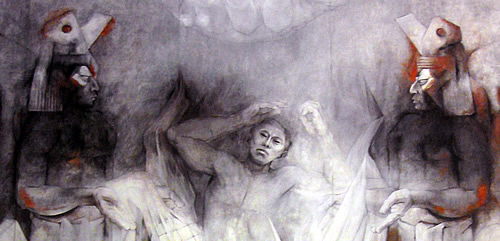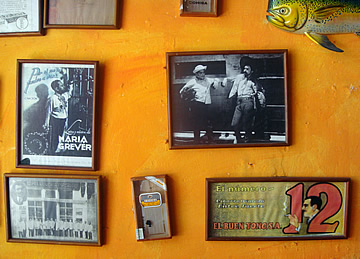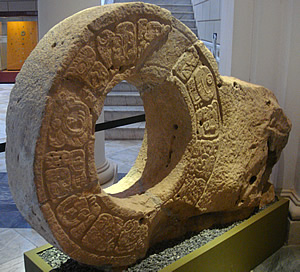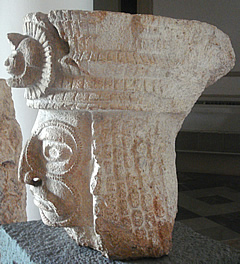


Merida, the capital city of the Yucatan, is a lively place with a wealth of Mayan artefacts, wonderful Mayan-inspired murals, Catherwood's original lithographs of Mayan sites and some great places to eat.

In Merida we stayed at the small but beautiful Hacienda Merida. Very friendly staff, great breakfasts by the pool and first rate cocktails.
It was a few blocks from the centre so a bit of a hike but not too bad.



Merida was under the control of the Spanish for three hundred years after the original Mayan city of Tihoo was conquered in 1542 by Francisco de Montejo.





Montejo built the cathedral using stone from the dismantled Mayan pyramids. Though the facade is now baroque, the interior is much simpler and houses a replica of the celebrated wooden "Christ of the Blisters". Legend has it that it was made from a tree which burst into flames when struck by lightning but did not char, and survived a fire relatively unscathed, only to be destroyed when the cathedral was sacked by revolutionaries in 1915.
We had some good food in Merida. On our first evening we went to Amaro, the highlight being a very theatrical preparation of crepes with orange sauce and cointreau!
The following day we spent exploring the city.


Merida is the capital of the region and very lively. We happened to be there on Mother's Day and there was a great band playing, more like an orchestra, near the Church of Jesus. Children were taking part in a ceremony beaneath a lovely statue of a mother showing a new baby to her elder child.


From there we headed to Merida's main square, the shady Zocalo, where the cathedral and the Govenor's Palace are located.

The palace has a lovely cool green and white arcaded courtyard and is hung with a series of huge murals by the Merida artist Fernando Castro Pacheco. These depict the history of the peninsula, some of them very powerful and describing the subjugation of the Mayan people. There's also one of furtive-looking English pirates who attacked the coast in the seventeenth and eighteenth centuries and occupied Belize.









We had lunch in a great bar on Calle 60 near Hidalgo Park: chicken fajitas and a very good pizza with spicy sauces. The decoration of the bar was great fun, lots of old photos and bright, surprising artefacts.


The Englishman Frederick Catherwood was an avid explorer of ancient antiquities and came to Central America with his friend John Lloyd Stephens, an American lawyer equally fascinated by ancient civilisations. They had both explored historic European and Egyptian locations such as Rome, Jerusalem and Thebes but in 1839 they travelled together to discover the lost world of the Maya.1
We were very keen to visit Casa Catherwood2 in Merida where a collection of original lithographs are displayed. Unfortunately our map had it in the wrong place and it took a while to find! It was well worth the effort, though, to see a couple of dozen or so images of Mayan sites such as Uxmal and Copan.

Walking back we passed the beautiful 17th century Church of Santiago.



A very hot afternoon and we retreated to the cool Museum of Anthropology and History housed in the ornate Palacio Canton.

There are several representations of jaguars highlighting its importance in Mayan mythology. The jaguar was the powerful creature of the night, feared by the Mayans as a symbol of death. Ahau Kin was the name of a Mayan sun god who, after dark, became the jaguar god, lord of the underworld.3















Tzompantli or skull racks, displayed arrays of human skulls, probably from sacrificial victims, prisoners or slain enemies.
Carved stone versions are also found on the sides of low platforms at many sites including Chichen Itza. The platforms probably supported the real thing!
There are also some very jolly-looking carvings of skulls, some with hinged jaws, perhaps just decorative objects - the Maya were fascinated by death and the dead so they could even be jewellery!

It was so hot that day we went back to the hotel to rest in the shade before excellent cocktails at the hotel bar - a particularly good Margarita Maya made with an anise/honey liquer.

We ate at Chaya Maya that night and had a terrific meal, choosing a combo of four traditional dishes: pavo en sac col indio - baked turkey in a thick turkey sauce, pavo en pipian - turkey simmered in a rich pumpkin seed mole, a very good spicy cochinita pibil - suckling pig marinated with achiote (a red paste made from a blend of spices), sour orange sauce, spices, sweet chili, tomato and onion then cooked in banana leaves, and a pavo in relleno negro - turkey cooked in a spicy sauce made from several varieties of blackened chilis and spices which also have the side effect of turning the food black! Plus freshly made tortillas - a couple of ladies stationed in the window make tortillas continuously - and beers. A great meal and a great way to end our stay in Merida - though we had excellent caiprinhas back at the hotel just to finish off!